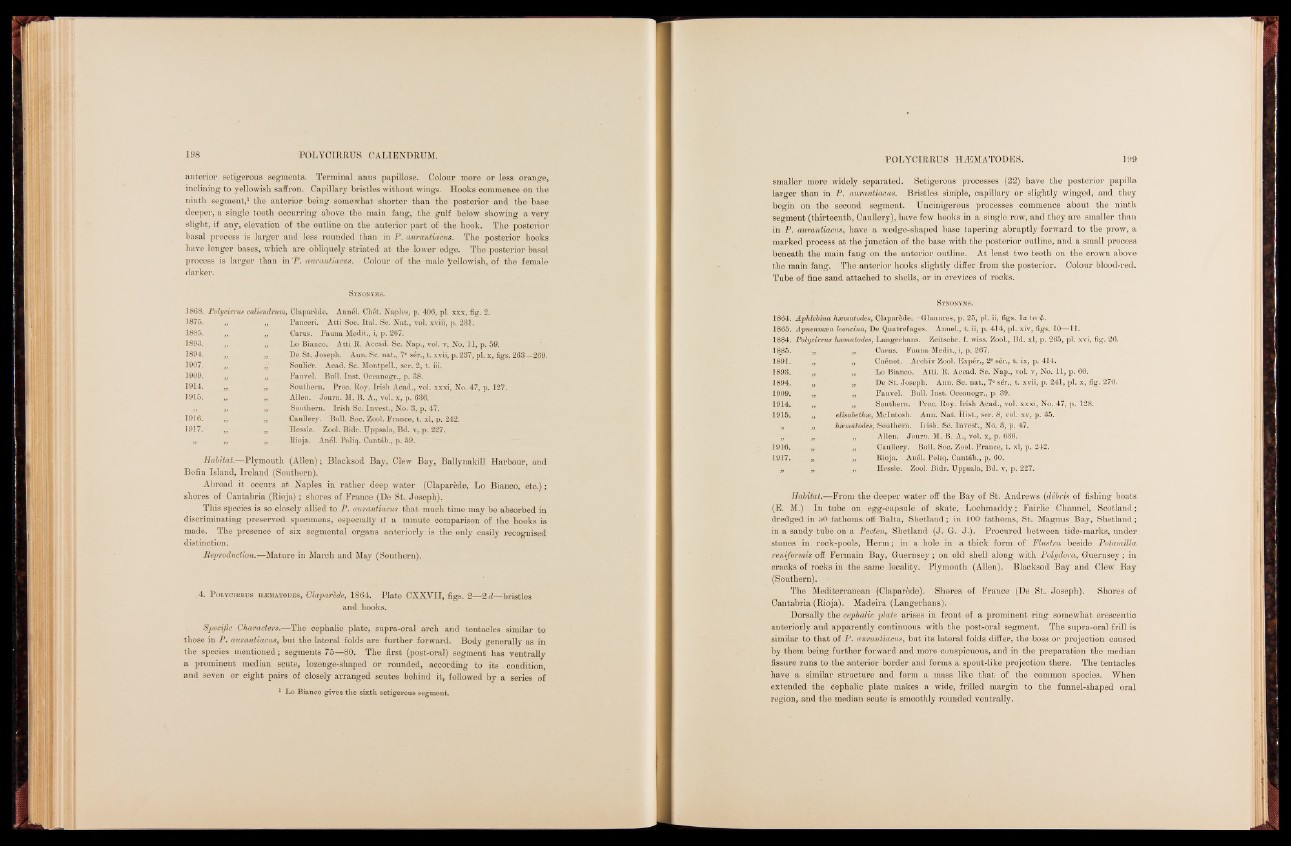
anterior setigerous segments. Terminal anus papillose. Colour more or less orange,
inclining to yellowish saffron. Capillary bristles without wings. Hooks commence on the
ninth segment,1 the anterior being somewhat shorter than the posterior and the base
deeper, a single tooth occurring above the main fang, the gulf below showing a very
slight, if any, elevation of the outline on the anterior part of the hook. The posterior
basal process is larger and less rounded than in P. aurantiacus. The posterior hooks
have longer bases, which are obliquely striated at the lower edge. The posterior basal
process is larger than in P. aurantiacus. Colour of the male yellowish, of the female
darker.
Sy:NONYMS.
1868.
1875.
1885.
1898.
1894.
1907.
1909.
1915.
Polycirrus caliendmm, Clapai*ede. Anuel. Chet. Naples, p. 406, pi. xxx, fig. 2.
„ „ Panceri. Afcfci Soc. Ital. Sc. Nat., vol. xviii, p. 231.
„ „ Caras. Fauna Medit., i, p. 267.
„ „ Lo Bianco. Atti R. Accad. Sc. Nap., vol. v, No. 11, p. 59.
„ „ De St. Joseph. Ann. Sc. nat., 7° sei\, t. xvii, p. 237, pi. x, figs. 263—269.
„ SoulieV. Acad. Sc. Montpell., ser. 2, t. iii.
„ „ Faavel. Bull. Inst. Oceanogr., p. 38.
„ „ Southern. Proc. Boy. Irish Acad., vol. xxxi, No. 47, p. 127.
,, „ Allen. Journ. M. B. A., vol. x, p. 636.
„ „ Southern. Irish Sc. Invest., No. 3, p. 47.
„ ,, Caullery. Bull. Soc. Zool. France, t. xl, p. 242.
„ „ Hessle. Zool. Bidr. Uppsala, Bd. v, p. 227.
„ „ Rioja. Anel. Poliq. CantAb., p. 59. ~
Habitat.—Plymouth (Allen) ; Blacksod Bay, Clew Bay, Ballynakill Harbour, and
Bofin Island, Ireland (Southern).
Abroad it occurs at Naples in rather deep water (Claparède, Lo Bianco, etc.);
shores of Cantabria (Rioja) ; shores of France (De St. Joseph).
This species is so closely allied to P. aurantiacus that much time may be absorbed in
discriminating preserved specimens, especially if a minute comparison of the hooks is
made. The presence of six segmental organs anteriorly is the only easily recognised
distinction.
Reproduction.—Mature in March and May (Southern).
. 4. POLYCIRBUS hjsmatodes, Claparede, 1864. Plate CXXVII, figs. 2—2 d—bristles
and hooks.
Specific Characters.—The cephalic plate, supra-oral arch and tentacles similar to
those in P. aurantiacus, but the lateral folds are further forward. Body generally as in
the species mentioned; segments 75—80. The first (post-oral) segment has ventrally
a prominent median scute, lozenge-shaped or rounded, according to its condition
and seven or eight pairs of closely arranged scutes behind it, followed by a series of
1 Lo Bianco gives the sixth setigerous segment.
smaller more widely separated. Setigerous processes (22) have the posterior papilla
larger than in P. aurantiacus. Bristles simple, capillary or slightly winged, and they
begin on the second segment. Uncinigerous processes commence about the ninth
segment (thirteenth, Caullery), have few hooks in a single row, and they are smaller than
in P. aurantiacus, have a wedge-shaped base tapering abruptly forward to the prow, a
marked process at the junction of the base with the posterior outline, and a small process
beneath the main fang on the anterior outline. At least two teeth on the crown above
the main fang. The anterior hooks slightly differ from the posterior. Colour blood-red.
Tube of fine sand attached to shells, or in crevices of rocks.
Synonyms.
1864. Aphlebina hæmatodes, Claparède. ' Gianures, p. 25, pi. ii, figs, la to 4-
1865. Apneumæa leoncina, De Quatrefages. Annel., fc. ii, p. 414, pi. xiv, figs. 10—11.
1884. PolyciiTUs hæmatodes, Langerhans. Zeitschr. f. wiss. Zool., Bd. xl, p. 265, pi. xvi, fig. 26.
1885. „ ,, Carus. Fauna Medit., i, p. 267.
1891. „ „ Cuénot. Arcliiv Zool. Expér., 2e sér., t. ix, p. 414.
1893. „ „ Lo Bianco. Atti. R. Accad. Sc. Nap., vol. v, No. 11, p. 60.
1894. „ „ De St. Joseph. Ann. Sc. nat., 7e sér., t. xvii, p. 241, pi. x, fig. 270.
1909. „ ,, Fauvel. Bull. Inst. Oceanogr., p. 39.
1914. ,, ,, Southern. Proc. Roy. Irish Acad., vol. xxxi, No. 47, p. 128.
1915. „ elisabethæ, McIntosh. Ann. Nat. Hist., ser. 8, vol. xv, p. 35.
„ „ hæmatodes, Southern. Irish. Sc. Invest., No. 3, p. 47.
„ „ „ Allen. Journ. M. B. A., vol. x, p. 636.
1916. ,, „ Caullery. Bull. Soc. Zool. France, t. xl, p. 242.
1917. „ „ Rioja. Anél. Poliq. Cant&b., p. 60.
„ „ „ Hessle. Zool. Bidr. Uppsala, Bd. v, p. 227.
Habitat.—From the deeper water off the Bay of St. Andrews (debris of fishing boats
(E. M.) In tube on egg-capsule of skate, Lochmaddy ; Fairlie Channel, Scotland ;
dredged in 50 fathoms off Balta, Shetland ; in 100 fathoms, St. Magnus Bay, Shetland ;
in a sandy tube on a Pecten, Shetland (J. G. J.). Procured between tide-marks, under
stones in rock-pools, Herm ; in a hole in a thick form of Flustra beside Potamilla
reniformis off Fermain Bay, Guernsey ; on old shell along with Poly dora, Guernsey ; in
cracks of rocks in the same locality. Plymouth (Allen). Blacksod Bay and Clew Bay
(Southern).
The Mediterranean (Claparède). Shores of France (De St. Joseph). Shores of
Cantabria (Rioja). Madeira (Langerhans).
Dorsally the cephalic plate arises in front of a prominent ring somewhat crescentic
anteriorly and apparently continuous with the post-oral segment. The supra-oral frill is
similar to that of P. aurantiacus, but its lateral folds differ, the boss or projection caused
by them being further forward and more conspicuous, and in the preparation the median
fissure runs to the anterior border and forms a spout-like projection there. The tentacles
have a similar structure and form a mass like that of the common species. When
extended the Cephalic plate makes a wide, frilled margin to the funnel-shaped oral
region, and the median scute is smoothly rounded ventrally.